
Ceuta is a Spanish autonomous city on the north coast of Africa.

Melilla is an autonomous city of Spain located in north Africa. It lies on the eastern side of the Cape Three Forks, bordering Morocco and facing the Mediterranean Sea. It has an area of 12.3 km2 (4.7 sq mi). It was part of the Province of Málaga until 14 March 1995, when the Statute of Autonomy of Melilla was passed.

The Ceuta border fence forms part of the Morocco–Spain border at Ceuta, a city on the North African coast. Constructed by Spain, its purpose is to prevent smuggling and to stop migrants from entering Europe. Morocco objected to the construction of the barrier since it does not recognize Spanish sovereignty in Ceuta.
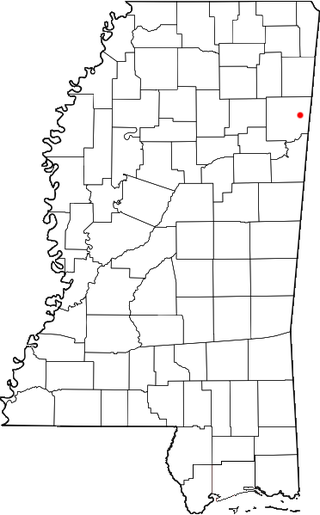
Greenwood Springs is an unincorporated community in Monroe County, Mississippi.
The Battle of Tetuan was fought on 4 to 6 February 1860, near Tetuan, Morocco, between a Spanish army sent to North Africa and the tribal levies which at the time made up the Moroccan Army. The battle was part of the Spanish-Moroccan War of 1859–1860.

The Roman Catholic Archdiocese of Tanger is a Roman Catholic archdiocese in Morocco. Headquartered in Tangier, it is immediately subject to the Holy See.

The Península de Almina is a peninsula making up much of the eastern part of the Spanish city of Ceuta in Africa. It is dominated by the peak of Monte Hacho. The peninsula contains Ceuta's easternmost point, Punta Almina, and is connected to the rest of Ceuta by an isthmus barely 100 metres (330 ft) in width.

The Cathedral of St Mary of the Assumption is a Roman Catholic church located in the Spanish city of Ceuta, in a small exclave on the northwest coast of Africa.

MoroccoandSpain maintain extensive diplomatic, commercial, and military ties. Morocco’s foreign policy has focused on Western partners, including neighboring Spain. They have however, been historically intense and conflictive.
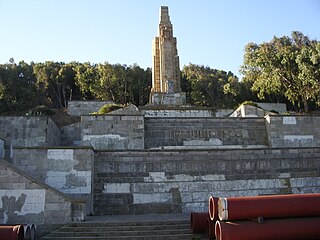
Monumento del Llano Amarillo is a monument in the Spanish territory of Ceuta, in the North of Africa, at the bottom of Mount Hacho. The fifteen metre monument was moved here from Morocco in 1962 and it is one of the few sculptures left that record Spain's period of Nationalism following the Spanish Civil War.
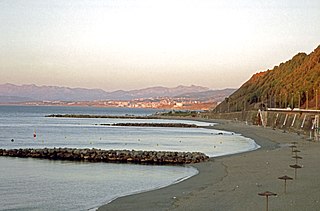
Playa del Chorrillo is a beach of Ceuta, a Spanish city bordering northern Morocco. Like the Playa de la Ribera, it lies to the south of the isthmus. It has a length of about 1200 metres and average width of 30 metres, with black sand.

Playa de la Ribera is a beach of Ceuta, a Spanish city bordering northern Morocco. Like the Playa del Chorillo, it lies to the south of the isthmus but on the part where it joins the mainland. It is about 405 metres long, with an average width of 40 metres. It is very busy during the summer months.
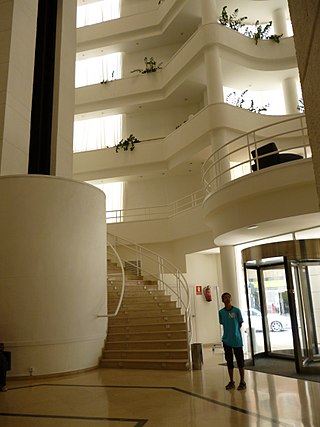
Hotel Ceuta Puerta de Africa is a hotel in Ceuta, a Spanish city bordering northern Morocco. It is located near the Palacio Municipal in the centre of the city, near the corner of Avenida Alcalde Antonio L. Sánchez Prados and the Plaza de África. The hotel has 117 rooms, two suites, a restaurant, bar and conference rooms which accommodate up to 530 people.
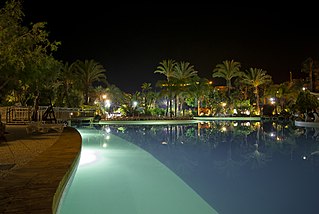
The Parque Marítimo del Mediterráneo is a leisure complex covering 55,000 m2 located in the autonomous Spanish city of Ceuta, bordering northern Morocco. It consists of three artificial lakes of salt water, filtered directly from the sea. These are suitable for swimming during the summer months. The park also contains gardens, ornamental waterfalls, sunbathing areas, a stage for concerts and shows and various entertainment establishments such as bars, restaurants, pubs, a casino, and a nightclub, etc. It was designed by the versatile Lanzarote-born artist César Manrique and inaugurated in 1995, nearly three years after his death. It has similarities with Parque Marítimo César Manrique in Puerto de la Cruz, Tenerife, designed by the same architect two decades earlier. In the centre of the complex is a unique building, as it mimics the Royal Walls of Ceuta and the moat of San Felipe. This building houses the casino, a nightclub and a restaurant. The park also has a permanent exhibition about its creator, Manrique.

The Tingitan Peninsula, also known as the Tangier Peninsula, is a small peninsula in northwest Africa, which together with the southernmost part of mainland Spain, forms the Strait of Gibraltar, the Atlantic Ocean boundary with the Mediterranean Sea. The principal cities are Tangier, Tétouan and Ceuta. Administratively, the peninsula belongs to the Moroccan prefectures of Tanger-Assilah, Fahs-Anjra, M'Diq-Fnideq and Tetouan, and the Spanish autonomous city of Ceuta. Historically it belonged to the province of Mauretania Tingitana.

Playa Benítez is a beach of Ceuta, a Spanish city bordering northern Morocco. The beach is about 900 metres (3,000 ft) in length with an average width of about 200 metres (660 ft). It forms part of the Punta Blanca. The beach is popular with sports enthusiasts.

Playa El Tarajal is a beach of Ceuta, bordering northern Morocco. The beach is about 250 metres in length with an average width of about 15 metres.

The Palacio de las Academias is a Neo-Gothic building on the Avenida Universidad in the centre of Caracas, Venezuela. It dates back to 1684 when a Franciscan convent was built on the site but in the 19th century it served as a barracks, a hospital and a college. In 1876, under President Antonio Guzmán Blanco, the Universidad de Caracas was moved to the building, whose former colonial façade was rebuilt in the Neo-Gothic style. After the university relocated to a new campus in 1952, the building became home to the National Academies. In 1965, it was listed as a national monument. The Palacio de las Academias now houses six National Academies, which are the National Academy of History, the Venezuelan Academy of Language, the Academy of Medicine, the Academy of Political and Social Sciences, the Academy of Jurisprudence, and the Academy of Physics, Mathematics and Nature.
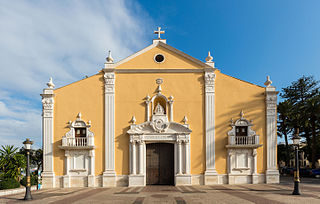
The Church of Santa María de África is a Roman Catholic church in the Spanish city of Ceuta which is located in a small Spanish exclave on the north coast of Africa.

The Morocco–Spain land border consists of three non-contiguous lines totalling 18.5 km around the Spanish territories of Ceuta, Peñón de Vélez de la Gomera and Melilla. Spanish islets such as the Chafarinas or the Alhucemas are located off the Moroccan coast.




















